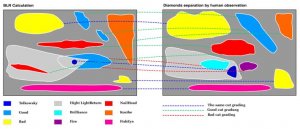- Joined
- Sep 3, 2000
- Messages
- 6,756
Beauty of oight performance in a round diamond is measured by Brillancy, Sparkle and Intensity. These three terms are thorougly defined already on my website and elsewhere.
I would suggest that to understand how they work together lets imagine fine food. There is a certain look to our eyes, a certain smell to our nose, and a taste on our tongue. If the look of the food is brillancy, the smell is sparkle and the taste is intensity, think of what happens if any one of these three elements of food are adjusted. If one changes the pepper or salt level of a fine food it can rapidly degrade its quality and desirablility. If one changes the aromatic nature to too intense or eliminates the aroma, the food may become far less inviting. If one dyes the food blue, we almost all agree it is less appealing.
Any one part of this three part recipe may have quite an effect on the overall beauty of the food. There is a certain range of balance between ingredients and layout that maximizes the benefits. At least with food, there is.
My question is, how have those who will use light prediction formulas arrived at the recipes for proper blending of these three aspects for actual appearance and beauty. What assurance are they giving us that there is not too much of one component or not enough of another in their model's theory? This is not an attack, but a question that we have yet to discuss.
In work I have been a part of, we used a sufficient statistical sample of real diamonds to determine the proper blend of the three key elements. I have seen a couple light predictive tools that have no apparent basis other than to say "more is better". Can one reach a "more is less" postion in a diamond, too? What do you think?
PUN: Food for thought!
Have a wonderful day Pricescopers.
I would suggest that to understand how they work together lets imagine fine food. There is a certain look to our eyes, a certain smell to our nose, and a taste on our tongue. If the look of the food is brillancy, the smell is sparkle and the taste is intensity, think of what happens if any one of these three elements of food are adjusted. If one changes the pepper or salt level of a fine food it can rapidly degrade its quality and desirablility. If one changes the aromatic nature to too intense or eliminates the aroma, the food may become far less inviting. If one dyes the food blue, we almost all agree it is less appealing.
Any one part of this three part recipe may have quite an effect on the overall beauty of the food. There is a certain range of balance between ingredients and layout that maximizes the benefits. At least with food, there is.
My question is, how have those who will use light prediction formulas arrived at the recipes for proper blending of these three aspects for actual appearance and beauty. What assurance are they giving us that there is not too much of one component or not enough of another in their model's theory? This is not an attack, but a question that we have yet to discuss.
In work I have been a part of, we used a sufficient statistical sample of real diamonds to determine the proper blend of the three key elements. I have seen a couple light predictive tools that have no apparent basis other than to say "more is better". Can one reach a "more is less" postion in a diamond, too? What do you think?
PUN: Food for thought!
Have a wonderful day Pricescopers.


















300x240.png)